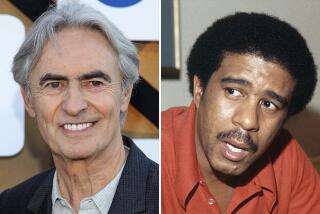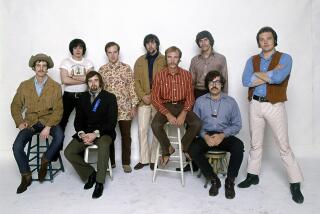What Really Tore Down the Iron Curtain : PARTING THE CURTAIN: Propaganda, Culture, and the Cold War, 1945-1961 by Walter L. Hixson; St. Martin’s Press; $45, 243 pages
When the Iron Curtain began to collapse in 1989, it seemed to fall abruptly and under its own weight. But the fact is that the fortress of communism in Russia and Eastern Europe had been undermined for decades by a campaign of cultural subversion in which rock ‘n’ roll and refrigerators were the most important weaponry.
“American mass culture has been one of the country’s greatest foreign policy assets,” writes Walter Hixson in “Parting the Curtain,” his study of psychological warfare against the Soviet bloc during the Cold War. “Support for the Soviet regime dwindled, while opposition reached a critical mass.”
The psychological and propaganda warfare undertaken by the United States was hardly a secret, and the shortwave radio broadcasts of the government-sponsored Voice of America were only the most obvious examples. Thanks to the steady infiltration of American books, movies, records, cigarettes, clothing and soft drinks, the American way of life sold itself. As historian Reinhold Wagnleitner put it, U.S. foreign policy in the ‘50s was based on “Coca-Colonization” and “the Marilyn Monroe Doctrine.”
Hixson allows us a scholarly but intriguing glimpse into the inner workings of the American propaganda machinery of the early Cold War era. For example, we see how the Voice the America prepared the 24-hour-a-day broadcasts that eventually reached some 100 million listeners around the world--and we see how the Soviets countered with ongoing attempts to jam the radio signal with a noise described as “the buzzing of a gigantic electric razor, mixed with a scraping noise and the roar of a squadron of B-24s.”
The battle for the “hearts and minds” of the Communist world, as Hixson explains, was hindered by hostile forces both at home and abroad. Ironically the VOA was attacked by right-wing critics as “a haven for Communists and sexual deviants” and came under the guns of Sen. Joseph McCarthy, who embarked on “a hunt for subversives among Voice employees.” Throughout the Cold War, vastly greater resources were devoted to military showmanship and diplomatic showdowns than to cultural propaganda and psychological warfare operations.
Stalin and his successors, on the other hand, had always recognized the corrosive effect of American mass media and popular culture on Soviet society. Thus, the Soviet regime sought to shut off the flow of movies and music from the West. Hixson points out that the U.S. government inadvertently assisted the KGB during the McCarthy era: “The FBI hounded liberals and leftists who attempted to maintain contact with the Soviets,” he writes, “exercising a chilling effect on increasingly futile efforts to keep East-West cultural exchange alive.”
The tensions in between propaganda and policy exploded into crisis in 1956, when the people of Hungary rose up against their Soviet occupiers. The uprising was incited, at least in part, by inflammatory broadcasts over VOA and its private counterpart, Radio Free Europe, which seemed to hold out the promise that the United States would come to the rescue of the freedom fighters. The uprising was crushed by Soviet tanks, and the United States did nothing.
In the aftermath of the Hungarian debacle, Hixson explains, American propaganda took on new subtlety and restraint. The jazz on VOA was cool, the propaganda message was even cooler, and the payoff came in 1958 when the United States and the Soviet Union signed a cultural exchange agreement that led to an exhibition of American consumer culture in Moscow, the site of the famous “kitchen debate” between Richard Nixon and Nikita Khrushchev. As these two bombastic politicians traded barbs in front of the television cameras, they stood amid a lavish display of American household appliances that spoke more eloquently than either of them about the material rewards of capitalism.
As we discover in “Parting the Curtain,” the freedom fighters in the struggle against communism included the so-called stiliagi or “style-hunters,” young men and women in the Soviet Union who “ ‘hung out,’ held cocktail hours, smoked Lucky Strikes and Camels, wore Western fashions, and listened to jazz,” as Hixson writes. Long before the underground publishing network known as samizdat, they were using old X-ray film to make their own crude jazz records, a practice known as “recording on the bones.” The regime set “music patrols” on the trail of the stiliagi, but they failed to find or eradicate the underground music makers.
Here we find the real reason why the Iron Curtain crumbled. American propaganda helped to spawn and nurture a generation of Russians and Eastern Europeans who were hooked on Dizzy Gillespie, Pepsi-Cola, Thunderbirds and Marilyn Monroe. Against the contagion of what the regime called “decadent Western disease,” Hixson explains, the mighty edifice of Soviet power was helpless.
More to Read
Sign up for our Book Club newsletter
Get the latest news, events and more from the Los Angeles Times Book Club, and help us get L.A. reading and talking.
You may occasionally receive promotional content from the Los Angeles Times.







